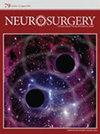赛博刀放射外科治疗无功能垂体腺瘤的长期疗效
IF 3.9
2区 医学
Q1 CLINICAL NEUROLOGY
引用次数: 0
摘要
背景和目的立体定向放射外科手术(SRS)作为一种重要的辅助治疗方式,已被广泛用于治疗无功能垂体腺瘤(NFPA)。然而,目前关于 SRS 对垂体腺瘤的长期影响的研究主要受限于样本量小和随访时间短。我们对 2008 年 2 月至 2021 年 7 月期间在一家机构接受了赛博刀放射外科手术的 178 例 NFPA 患者进行了回顾性研究。结果在49.7个月(2.5-158.1个月)的中位放射学随访期间,只有11例(7.0%)患者出现肿瘤进展。3年、5年和10年的无进展生存率分别为97.47%、95.57%和93.04%。27例(16.9%)患者被诊断为新发垂体功能减退症,中位临床随访时间为71.2个月(范围为11.5-175.4个月)。从 SRS 到新发垂体功能减退症的中位时间为 28.3 个月(2.8-101.7 个月)。3年、5年和10年后新发垂体功能减退症的累积发生率分别为8.47%、12.43%和15.25%。生物有效剂量>140 Gy和单次等效剂量>16.0 Gy是新发垂体功能减退症的重要风险因素(P = .046)。15例(8.4%)患者出现了其他不良事件,其中9例(5.1%)出现了新的视觉障碍。新视觉障碍的发生与治疗前肿瘤体积大于 2.5 mL 有关(P = 0.044)。本文章由计算机程序翻译,如有差异,请以英文原文为准。
Long-Term Outcomes After Cyberknife Radiosurgery for Nonfunctioning Pituitary Adenomas.
BACKGROUND AND OBJECTIVES
Stereotactic radiosurgery (SRS) has been widely adopted as an important adjunctive treatment modality for managing nonfunctioning pituitary adenomas (NFPAs). However, current studies on the long-term effects of SRS on pituitary adenomas have been largely limited by small sample sizes and short follow-up periods. The aim of this study was to evaluate the long-term outcomes of SRS for NFPAs.
METHODS
We conducted a retrospective review of 178 patients with NFPAs who received Cyberknife radiosurgery at a single institution between February 2008 and July 2021. Long-term outcomes of tumor control, new-onset hypopituitarism, and new visual disorders were assessed.
RESULTS
During a median radiological follow-up of 49.7 months (range, 2.5-158.1 months), only 11 (7.0%) patients experienced tumor progression. The progression-free survival at 3, 5, and 10 years was 97.47%, 95.57%, and 93.04%, respectively. New-onset hypopituitarism was diagnosed in 27 (16.9%) patients with a median clinical follow-up duration of 71.2 months (range, 11.5-175.4 months). The median time from SRS to new-onset hypopituitarism was 28.3 months (range, 2.8-101.7 months). The cumulative incidence of new-onset hypopituitarism at 3, 5, and 10 years was 8.47%, 12.43%, and 15.25%, respectively. Biological effective dose >140 Gy and single fraction equivalent dose >16.0 Gy were significant risk factors for new-onset hypopituitarism (P = .046). Other adverse events were experienced by 15 (8.4%) patients, 9 (5.1%) of whom presented with new visual disorders. Development of new visual disorders was associated with a pretreatment tumor volume of >2.5 mL (P = .044).
CONCLUSION
SRS is an effective and relatively safe means of managing both primary and residual/recurrent NFPAs.
求助全文
通过发布文献求助,成功后即可免费获取论文全文。
去求助
来源期刊

Neurosurgery
医学-临床神经学
CiteScore
8.20
自引率
6.20%
发文量
898
审稿时长
2-4 weeks
期刊介绍:
Neurosurgery, the official journal of the Congress of Neurological Surgeons, publishes research on clinical and experimental neurosurgery covering the very latest developments in science, technology, and medicine. For professionals aware of the rapid pace of developments in the field, this journal is nothing short of indispensable as the most complete window on the contemporary field of neurosurgery.
Neurosurgery is the fastest-growing journal in the field, with a worldwide reputation for reliable coverage delivered with a fresh and dynamic outlook.
 求助内容:
求助内容: 应助结果提醒方式:
应助结果提醒方式:


